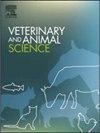Nutrients utilization and enteric methane emission in zebu cattle fed low quality forages
IF 1.9
Q2 AGRICULTURE, DAIRY & ANIMAL SCIENCE
引用次数: 0
Abstract
During the dry season in sub-Saharan Africa, ruminants are commonly fed low-quality forages, such as rangeland fodder and harvested grasses. This study evaluated the effects of four such forages - rangeland fodder (RF), Brachiaria ruziziensis (Bruzi), Andropogon gayanus (Agaya), and Panicum maximum (Pmaxi), all harvested at maturity (24 months) on feed intake, diet digestibility, and enteric methane (eCH₄) emissions. Ten Sudanese Fulani zebu steers (27.7 ± 4.6 months of age, 143.7 ± 15.7 kg of initial body weight - BW) were fed each forage at 2.3 % and 3.2 % of body weight (dry matter – DM basis) over three-week periods, two weeks of adaptation and one week of data collection. The forages differed significantly in chemical composition, affecting feed intake, diet digestibility, and eCH₄ emissions. The Pmaxi, with superior nutritional quality, was the most consumed and had the highest apparent digestibility (0.49; P < 0.001). At low-quality stage, all the forages had similar eCH4 yield potential (28.5 - 31.6 g/kg DM intake; P = 0.486). Methane conversion rate (Ym) ranged from 8.6 % in Pmaxi to 9.6 % of gross energy intake in Agaya; however, the variation was not statistically significant. Feeding ruminants over ad libitum low-quality forages did not affect their feed intake, diet apparent digestibility and eCH4 emissions. Measuring eCH4 emissions induced by these forages at different growth stages can help identify their optimal use for promoting both feed and environmental sustainability.
低品质牧草对瘤牛养分利用及肠道甲烷排放的影响
在撒哈拉以南非洲的旱季,反刍动物通常被喂食低质量的饲料,如牧场饲料和收获的草。本研究评估了牧场饲料(RF)、ruziziensis (Bruzi)、Andropogon gayanus (Agaya)和Panicum maximum (Pmaxi) 4种牧草在成熟期(24个月)采收对采食量、日粮消化率和肠道甲烷(eCH₄)排放的影响。选取10头苏丹富拉尼瘤牛(27.7±4.6月龄,143.7±15.7 kg初始体重-体重),分别饲喂体重(干物质-干重)的2.3%和3.2%的饲料,为期3周,分别进行2周的适应期和1周的数据收集期。不同饲料的化学成分差异显著,影响采食量、日粮消化率和乙酰胆碱排放。营养品质优良的Pmaxi是消耗量最大、表观消化率最高的品种(0.49;P < 0.001)。在低品质期,所有牧草的eCH4产量潜力相近(采食量28.5 ~ 31.6 g/kg, P = 0.486)。甲烷转化率(Ym)从Pmaxi的8.6%到Agaya的9.6%不等;然而,差异没有统计学意义。随意饲喂低品质饲料对反刍动物采食量、日粮表观消化率和ec4排放均无影响。测量这些牧草在不同生长阶段引起的eCH4排放可以帮助确定它们的最佳利用方式,以促进饲料和环境的可持续性。
本文章由计算机程序翻译,如有差异,请以英文原文为准。
求助全文
约1分钟内获得全文
求助全文
来源期刊

Veterinary and Animal Science
Veterinary-Veterinary (all)
CiteScore
3.50
自引率
0.00%
发文量
43
审稿时长
47 days
 求助内容:
求助内容: 应助结果提醒方式:
应助结果提醒方式:


